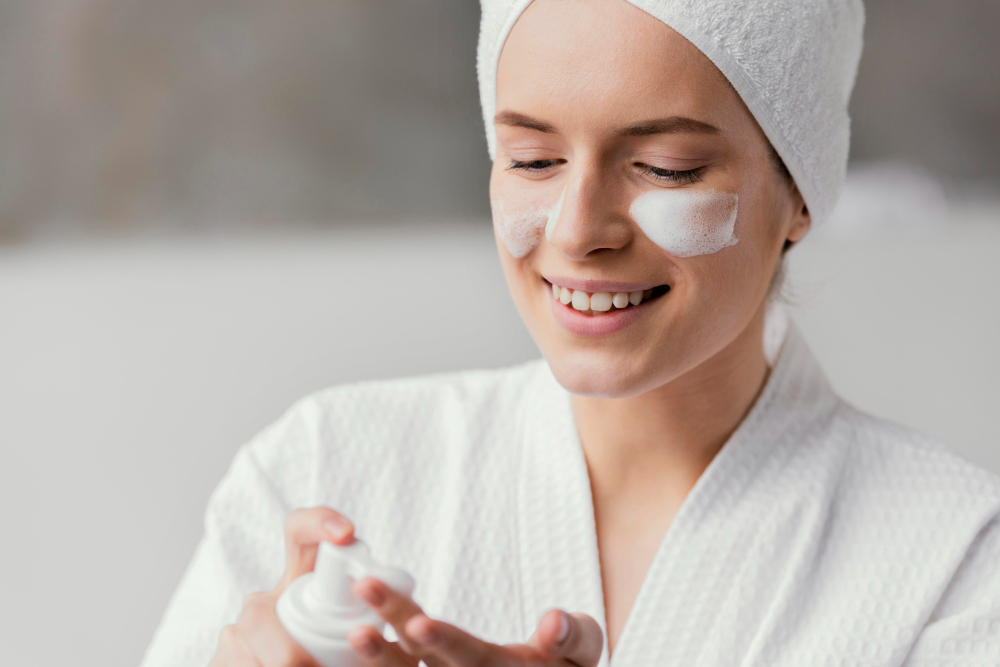In the world of skincare, the terms “moisturizer” and “face cream” are often used interchangeably. However, while they share similarities, they serve distinct functions and cater to different skin needs. Understanding the differences between moisturizers and face creams is crucial for developing an effective skincare routine tailored to your specific skin type and concerns.
This comprehensive guide will explore the key distinctions, ingredients, benefits, and usage tips for both moisturizers and face creams, helping you make informed choices for your skincare regimen.
What’s The Difference Between Moisturizer and Face Cream?
Moisturizers and face creams both hydrate the skin but differ in formulation and purpose. Moisturizers are typically lighter, providing hydration for daily use, while face creams are thicker, often designed to target specific skin concerns like anti-aging or repair. Face creams are generally used at night, while moisturizers can be applied throughout the day.
Understanding Moisturizers
Definition and Purpose
A moisturizer is a broad term used to describe any product that hydrates the skin. Its primary function is to prevent moisture loss by creating a protective barrier on the skin’s surface. Moisturizers are designed to address various skin concerns such as dryness, flakiness, and dehydration. They come in various formulations, including lotions, gels, and creams, each tailored to different skin types and needs.
Key Ingredients
Moisturizers typically contain a combination of the following key ingredients:

- Humectants: These ingredients, such as glycerin and hyaluronic acid, attract water from the environment and from deeper layers of the skin, helping to keep the skin hydrated.
- Emollients: Ingredients like squalane and fatty acids soften and smooth the skin by filling in the gaps between skin cells.
- Occlusives: Ingredients such as petrolatum and dimethicone form a protective layer on the skin’s surface to prevent water loss.
Benefits of Moisturizers
Moisturizers offer a range of benefits, including:
- Hydration: They help to maintain the skin’s moisture balance, preventing dryness and flakiness.
- Barrier Protection: Moisturizers form a protective barrier that shields the skin from environmental stressors and prevents moisture loss.
- Improved Skin Texture: Regular use of moisturizers can lead to softer, smoother skin.
- Anti-Aging: By keeping the skin hydrated, moisturizers help to reduce the appearance of fine lines and wrinkles.
Understanding Face Creams
Definition and Purpose
A face cream is a type of moisturizer that is typically richer and more emollient. Face creams are designed to provide intensive hydration and nourishment, making them ideal for individuals with dry or mature skin. They are often formulated with additional active ingredients that target specific skin concerns such as aging, pigmentation, and sensitivity.
Key Ingredients
Face creams generally contain a higher concentration of emollients and occlusives, as well as specialized active ingredients:
- Emollients: Ingredients like shea butter and cocoa butter provide deep hydration and nourishment.
- Occlusives: Rich ingredients such as beeswax and lanolin create a protective barrier to lock in moisture.
- Active Ingredients: Ingredients like retinol, peptides, and antioxidants target specific skin concerns, offering additional benefits beyond hydration.
Benefits of Face Creams
Face creams offer several key benefits:

- Deep Hydration: They provide intensive moisture, making them suitable for very dry or mature skin.
- Nourishment: The rich formulations deliver essential nutrients to the skin, improving overall skin health.
- Targeted Treatment: Face creams often include active ingredients that address specific skin issues such as aging, pigmentation, and sensitivity.
- Enhanced Barrier Protection: The occlusive properties of face creams help to strengthen the skin’s barrier function, preventing moisture loss and protecting against environmental damage.
Differences Between Moisturizers and Face Creams
Texture and Consistency
- Moisturizers: Typically lighter in texture, moisturizers come in various formulations such as lotions, gels, and light creams. They are designed for easy absorption and are suitable for all skin types, including oily and combination skin.
- Face Creams: Face creams are usually thicker and richer in consistency. They provide more intensive hydration and are ideal for dry, mature, or very dehydrated skin.
Hydration Levels
- Moisturizers: Offer basic hydration to maintain the skin’s moisture balance and prevent dryness. They are suitable for daily use and can be layered with other skincare products.
- Face Creams: Provide deep, long-lasting hydration and nourishment. They are especially beneficial during the colder months or for individuals with extremely dry skin.
Ingredient Composition
- Moisturizers: Formulated with a balance of humectants, emollients, and occlusives to provide lightweight hydration and barrier protection.
- Face Creams: Contain a higher concentration of emollients and occlusives, as well as active ingredients that target specific skin concerns.
Usage
- Moisturizers: Suitable for daily use, both morning and night. They can be used alone or layered with serums and sunscreens.
- Face Creams: Often used as a night treatment or during the day in harsh weather conditions. They can be applied after serums and before sunscreen.
How to Choose Between Moisturizers and Face Creams
Consider Your Skin Type
- Oily or Combination Skin: Opt for a lightweight moisturizer that hydrates without clogging pores. Gel-based or oil-free formulations are ideal.
- Dry or Mature Skin: Choose a rich face cream that provides intensive hydration and nourishment. Look for products with ingredients like shea butter, ceramides, and peptides.
Assess Your Skin Concerns
- Dehydration: Both moisturizers and face creams can address dehydration, but if your skin is extremely dry, a face cream may be more effective.
- Aging: If you are concerned about signs of aging, consider a face cream with active ingredients like retinol, peptides, or antioxidants.
- Sensitivity: For sensitive skin, choose a product with soothing ingredients such as aloe vera, chamomile, or oat extract.
Environmental Factors
- Climate: In humid climates, a lightweight moisturizer is often sufficient. In colder or drier climates, a richer face cream may be necessary to protect the skin.
- Season: During the summer, a lighter moisturizer may be more comfortable, while in the winter, a face cream can provide the extra hydration needed to combat dry air.
Application Tips
Moisturizers
- Cleanse: Start with a clean face to remove dirt, oil, and impurities.
- Tone: Apply a toner to balance your skin’s pH levels and enhance absorption.
- Serum: If using a serum, apply it before your moisturizer.
- Moisturize: Apply a small amount of moisturizer, gently massaging it into your skin using upward circular motions.
Face Creams
- Cleanse: Ensure your face is clean before applying any skincare products.
- Tone: Use a toner to prepare your skin for better absorption of the face cream.
- Serum: Apply any serums or treatments before the face cream.
- Apply Face Cream: Take a small amount of face cream and warm it between your fingers before gently pressing it into your skin. Focus on areas that are particularly dry or in need of extra care.
Conclusion
Understanding the difference between moisturizers and face creams is essential for tailoring your skincare routine to your specific needs. While moisturizers provide basic hydration and barrier protection suitable for all skin types, face creams offer intensive hydration and targeted treatment, making them ideal for dry, mature, or very dehydrated skin. By considering your skin type, concerns, and environmental factors, you can choose the right product to achieve healthy, radiant skin.







